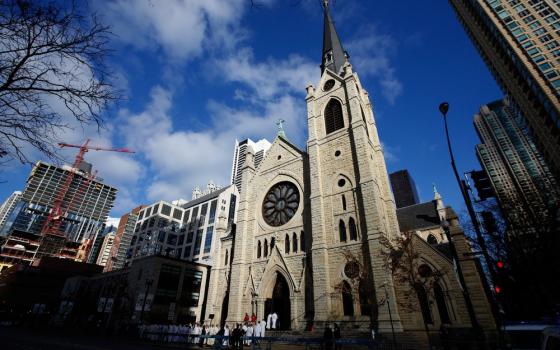
Rome
On day two of a plenary assembly of a gathering of international women religious superiors, with 800 women religious in the hall, a Spanish priest, representing the Vatican, celebrated Mass, standing alone, behind a twenty-foot long dais.
The separation, while symbolic, caught the attention of not a few women who spoke privately of the separation and growing strains between Vatican officials and women religious leaders.
The priest, Augustinian Father Eusebio Hernàndez Sola, had no altar servers to assist him. It was not immediately clear if it was by his choice or it the women had not approached him to offer aid.
It is not common for Vatican officials to officiate at Mass with female altar servers.
The Mass did, however, symbolize -- in a meeting that emphasizes symbols -- the growing gulf between Vatican prelates and women religious who increasingly feel the pains of discrimination based on gender.
During the last two plenary assemblies of the International Union of Superiors General, gatherings held here every few years, Slovenian Cardinal Franc Rodé, prefect of the Congregation for Institutes of Consecrated Life and Societies of Apostolic Life, attended and addressed the women.
Religious congregations report to Rodé’s congregation.
This year, however, assembly organizers were told Rodé would not be attending as he is out of town. In his place, Rodé sent a member of his congregation, Sola, a Spanish priest. 
During his homily, Sola thanked the women for their apostolic work, then went on to speak about “the persecution” the church faces today. He referred to sex abuse scandal that has rocked the church hierarchy.
Some women, however, said they found his inclusive references to persecution, at least as it pertained to this abuse crisis, confusing.
“But Jesus is with us,” he said. “Jesus will not abandon us.”
The theme of this year’s assembly, chosen by acclaim by the women, is “mysticism and prophecy.” Speakers have repeatedly emphasized the need for religious and their communities to cultivate the Spirit in order to more courageously proclaim the Word and live out the Gospels. Many of the women in attendance have come from parts of the world where women religious have suffered physical persecution, including the giving of their lives in their mission work.
Cultivating mysticism requires contemplation and discernment, speakers have said.
A related assembly theme has been a discernment that takes place in dark times. At a time when religious numbers are falling, especially in the West, when global strife and poverty appear deeply rooted in our world, when attacks on the environment continue unabated, the women, who stay close to those issues and needs, have responded positively to the call for discernment in difficult times.
Included in the darkness, included in the challenges the women face, have been their dealings with church prelates, here in Rome and locally with their bishops.
In instances throughout the world, tension have mounted. These tension have seem to have grown as women religious have had increased access to education, particularly theological and scriptural education.
In Asia, Latin America and in the Western world, women religious leaders have politely but firmly been raising gender related issues as they have moved for more inclusive types of leadership, first in their congregations, and then in the wider church.
Many of these efforts have been frustrated by top church prelates who see in their efforts acts of insubordination or disobedience.
Two recent examples involved U.S. women religious communities who last year did not respond, as requested, by the Vatican to a series of questions about their religious life. The questions were part of a three-year investigation of U.S. women religious communities ordered by the Vatican.
More recently, last month, in the hours leading up to the passage of a health care bill in the U.S. Congress, the Conference of U.S. Catholic Bishops expressed its opposition to the legislation, saying it would lead to public funding of abortions.
Several women religious organizations came to a different conclusion and supported the legislation. Many U.S. women religious leaders signed on in support of the bill, which eventually passed into law. Many bishops interpreted this move, on a political matter, as an act of disobedience.
It was the most visible sign so far of the rupture between bishops and women religious.
Meanwhile, when the program for this year’s international women religious general superiors’ assembly was first announced, an audience with Pope Benedict was on the schedule. Since then, however, the Vatican announced a papal trip by Pope Benedict to Portugal, meaning that the day for the planned papal audience was not to be.
Whether the scheduling of the papal visit to Portugal was intended to send a deliberate message to the women religious leaders or whether it was simply an oversight in planning by the Vatican, it has been viewed as an unfortunate development, as a symbolic slight to the women. Furthermore, it has meant that for some of the women religious who come out of poorer communities and for whom a trip to Rome is, perhaps, a once in a life time event, they will never set their eyes directly on the pope.
For them and others it is a disappointing development. Coming at a time of tension between the women religious and Vatican prelates, it has sent an unfortunate message that the pope has higher priorities than to personally receive the top women religious leaders of the world.
Instead, Cardinal Tarcisio Bertone, Vatican Secretary of State, sent a short telegram to the leaders of the conference telling them that "the Supreme Pontiff [is] present in spirit" and "sends his cordial wishes."
"His Holiness wishes that this important meeting stirs up renewed attachment and constant reverence to the Word of God to bear good fruits for the Church."
Meanwhile, the Vatican investigations of U.S. women religious, which began since the last meeting of the general superiors here, appear to have heightened tensions between Vatican prelates and some women religious leaders.
Not only is Rodé’s congregation involved in a three-year study of U.S. women religious, announced without their input, but the Vatican’s Congregation for the Doctrine of Faith is also investigating the Leadership Conference of Women Religious, an umbrella organization that represents 95 percent of all the U.S. women religious congregations. The congregation has suggested that LCWR has not adequately upheld official church teachings on the issues of women’s ordination, homosexuality and abortion.
In each instance gender related issues are involved.
As the women here continue to discern mysticism and prophecy, as they talk about how to gain courage to speak and act more prophetically, as they discuss how they can confront the ills of the world in the spirit of the Gospel, these women appear unable to avoid what appear to them to be church abuses of authority as well.
Many of the women religious leaders gathered here to support and learn from each other seem being drawn to address difficult questions about the roles they will play to become more fruitful agents of their own religious destinies.
Somehow, somewhere, serious discussions between the church prelates and women religious seem inevitable.
Fox is NCR Editor and can be reached at tfox@ncronline.org.





